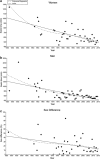Women cross the 'Catalina Channel' faster than men
- PMID: 26180752
- PMCID: PMC4495100
- DOI: 10.1186/s40064-015-1086-4
Women cross the 'Catalina Channel' faster than men
Abstract
Open-water ultra-distance swimming has a long history where the 'English Channel' (~33 km) was crossed in 1875 for the first time. Nowadays, the three most challenging open-water swims worldwide are the 21-miles (34 km) 'English Channel Swim', the 20.1-miles (32.2 km) 'Catalina Channel Swim' and the 28.5-miles (45.9 km) 'Manhattan Island Marathon Swim', also called the 'Triple Crown of Open Water Swimming'. Recent studies showed that women were able to achieve men's performance in the 'English Channel Swim' or to even outperform men in the 'Manhattan Island Marathon Swim'. However, the analysis of the 'Catalina Channel Swim' as part of the 'Triple Crown of Open Water Swimming' is missing. We investigated performance and sex difference in performance for successful women and men crossing the 'Catalina Channel' between 1927 and 2014. The fastest woman ever was ~22 min faster than the fastest man ever. Although the three fastest women ever were ~20 min faster than the three fastest men ever, the difference reached not statistical significance (p > 0.05). Similarly for the ten fastest ever, the ~1 min difference for women was not significant (p > 0.05). However, when the swimming times of the annual fastest women (n = 39) and the annual fastest men (n = 50) competing between 1927 and 2014 were compared, women (651 ± 173 min) were 52.9 min (16 ± 12%) faster than men (704 ± 279 min) (p < 0.0001). Across years, swimming times decreased non-linearly in the annual fastest men (polynomial 2nd degree) and women (polynomial 3rd degree) whereas the sex difference decreased linearly from 52.4% (1927) to 7.1% (2014). In summary, the annual fastest women crossed the 'Catalina Channel' faster than the annual fastest men. The non-linear decrease in swimming times suggests that female and male swimmers have reached a limit in this event. However, the linear decrease in the sex difference may indicate that women continuously narrow the gap to men.
Keywords: Men; Sex difference; Ultra-endurance; Women.
Figures
References
-
- Capranica L, Piacentini MF, Halson S, Myburgh KH, Ogasawara E, Millard-Stafford M. The gender gap in sport performance: equity influences equality. Int J Sports Physiol Perform. 2013;8:99–103. - PubMed
LinkOut - more resources
Full Text Sources
Other Literature Sources
Miscellaneous


